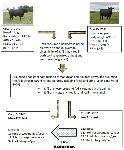Abstract
Selecting for feed efficiency based on residual food intake can significantly impact the amount of nutrients consumed and excreted per cow without compromising animal performance. Fresh manure output and excretions of phosphorous and nitrogen could be reduced by 29%, while methane emissions can be reduced by as much as 28% when selecting more feed-efficient animals. This 4-page fact sheet was written by Nicolas DiLorenzo and G. Cliff Lamb, and published by the UF Department of Animal Science, February 2012.
References
Basarab, J. A., M. A. Price, J. L. Aalhus, E. K. Okine, W. M. Snelling, and K. L. Lyle. 2003. Residual feed intake and body composition in young growing cattle. Can. J. Anim. Sci. 83:189-204. https://doi.org/10.4141/A02-065
Black, T. E. 2011. The relationship between performance, residual feed intake, and temperament assessed in growing heifers and subsequently as three-year-old suckled beef cows. M.S. Thesis. University of Florida, Gainesville.
Carstens, G. E., D. E. Johnson, and M. A. Ellenberger. 1989. Energy metabolism and composition of gain in beef steers exhibiting normal and compensatory growth. Energy Metab. Proc. Symp. 43:131-134.
Elzo, M. A., D. G. Riley, G. R. Hansen, D. D. Johnson, R. O. Meyer, S. W. Coleman, C. C. Chase, J. G. Wasdin, and J. D. Driver. 2009. Effect of breed composition on phenotypic residual feed intake and growth in Angus, Brahman, and Angus x Brahman crossbred cattle. J. Anim. Sci. 87:3877-3886. https://doi.org/10.2527/jas.2008-1553
Hegarty, R. S., J. P. Goopy, R. M. Herd, and B. McCorkell. 2007. Cattle selected for lower residual feed intake have reduced daily methane production. J. Anim. Sci. 85:1479-1486. https://doi.org/10.2527/jas.2006-236
Herd, R. M., J. A. Archer, and P. F. Arthur. 2003. Reducing the cost of beef production through genetic improvement in residual feed intake: Opportunity and challenges to application. J. Anim. Sci. 81:E9-E17.
Herd, R. M. and P. F. Arthur. 2009. Physiological basis for residual feed intake. J Anim. Sci. 87:E64-E71. https://doi.org/10.2527/jas.2008-1345
Hughes, H. 2011. The "new normal" - part II. Beef Magazine. August, 12-14.
Koch, R. M., L. A. Swiger, D. Chambers, and K. E. Gregory. 1963. Efficiency of feed use in beef cattle. J. Anim. Sci. 22:486-494. https://doi.org/10.2527/jas1963.222486x
Moore, S. S., F. D. Mujibi, and E. L. Sherman. 2009. Molecular basis for residual feed intake in beef cattle. J. Anim. Sci. 87:E41-E47. https://doi.org/10.2527/jas.2008-1418
Nkrumah, J. D., J. A. Basarab, M. A. Price, E. K. Okine, A. Ammoura, S. Guercio, C. Hansen, C. Li, B. Benkel, B. Murdoch, and S. S. Moore. 2004. Different measures of energetic efficiency and their phenotypic relationships with growth, feed intake, and ultrasound and carcass merit in hybrid cattle. J. Anim. Sci. 82:2451-2459. https://doi.org/10.2527/2004.8282451x
Nkrumah, J. D., E. K. Okine, G. W. Mathison, K. Schmid, C. Li, J. A. Basarab, M. A. Price, Z. Wang, and S. S. Moore. 2006. Relationships of feedlot feed efficiency, performance, and feeding behavior with metabolic rate, methane production, and energy partitioning in beef cattle. J. Anim. Sci. 84:145-153. https://doi.org/10.2527/2006.841145x
Richardson, E. C., R. M. Herd, V. H. Oddy, J. M. Thompson, J. H. Archer, and P. F. Arthur. 2001. Body composition and implications for heat production of Angus steer progeny of parents selected for and against residual feed intake. Aust. J. Exp. Agric. 41:1065-1072. https://doi.org/10.1071/EA00095
Richardson, E. C., and R. M. Herd. 2004. Biological basis for variation in residual feed intake in beef cattle. 2. Synthesis of results following divergent selection. Aust. J. Exp. Agric. 44:431-440. https://doi.org/10.1071/EA02221
Spiehs, M. J., and V. H. Varel. 2009. Nutrient excretion and odorant production in manure from cattle fed corn wet distillers grains with solubles. J. Anim. Sci. 87:2977-2984. https://doi.org/10.2527/jas.2008-1584

